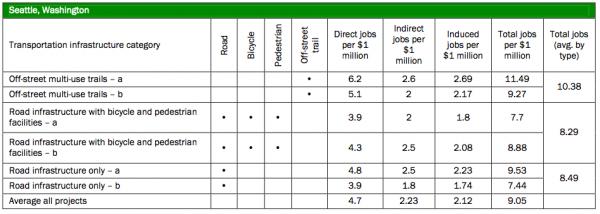 More jobs are created by building trails in Seattle than from road projects, according to a recent study (PDF) by Heidi Garrett-Peltier for the Political Economy Research Institute at the University of Massachusetts, Amherst (h/t Biking Bis).
More jobs are created by building trails in Seattle than from road projects, according to a recent study (PDF) by Heidi Garrett-Peltier for the Political Economy Research Institute at the University of Massachusetts, Amherst (h/t Biking Bis).
The study covered 11 cities around the country, from Seattle to Eugene to Houston. The researchers looked at 5-6 projects in each city that involved the creation of trails, walking and biking facilities or roads-only. Averaging all the studied cities together, projects that make streets safer for people walking and biking created consistently more jobs per $1 million spent than projects that include only roads.
In Seattle, trail projects were the clear leader in jobs, creating over ten jobs per $1 million spent. That’s two jobs more than road projects, whether bicycle and pedestrian facilities are included or not.
Though bicycle and pedestrian facilities created more jobs than road-only projects in other cities, they appear to be something of a wash in Seattle compared to projects that do not include them.
One reason projects like multi-use trails create more jobs could be that they are more labor intensive than they are material intensive. From the study:
Labor intensity refers to the ratio of labor to capital (materials, plant, and equipment). In labor-intensive industries such as construction and engineering, more of the total dollars spent go to wages and salaries. In more capital-intensive industries such as cement manufacturing, relatively fewer dollars are spent on salaries and more are spent on materials and equipment, in comparison to labor-intensive industries. Thus in the projects we studied, the infrastructure with higher labor intensity of production will create more jobs for a given level of spending. This is the primary reason why pedestrian-only and bicycle- only infrastructure create more jobs than road-only projects. For the former types, a greater portion of the spending is used to employ construction workers and engineers, both labor-intensive industries. In the latter, a greater proportion of the total spending is used for materials such as asphalt and stone products.
So it’s great news for construction workers and engineers in Washington State that WSDOT did not unfairly cut funding for walking and biking in this year’s federal rescissions. Perhaps this study will catch the eye of some labor unions that have been hit exceptionally hard by the recession. It would be great to have those unions lobbying to help connect the excellent, yet often fragmented, trail networks in our state, county and city.
After all, I would rather invest in making it safer and easier to walk and bike, but I would also rather invest in people than concrete and asphalt. According to this study, trails — whether just off-street or rail-trails — seem to accomplish both those goals.







